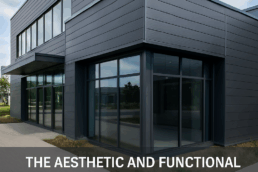When selecting the thickness of metal coping, it’s important to choose a size that ensures durability, aesthetic appeal, and structural strength, especially at higher elevations. Whether applied to a parapet wall or as part of an architectural feature, understanding the available metal thickness options will help you make the best choice. This guide outlines key considerations, standard thickness options, and how their performance can help determine the most suitable choice for your metal coping project.
Factors Affecting the Selection of Thickness for Metal Coping
Environmental Factors
When selecting the thickness for metal coping, environmental factors play a significant role. In areas with extreme weather conditions, such as high winds and heavy rain, thicker coping is typically required to withstand these elements. For buildings located near the ocean, the materials and coatings used for coping must be resistant to salt exposure to prevent corrosion. Similarly, in areas with high pollution levels, additional treatments and increased thickness may be necessary to ensure the coping resists the damaging effects of chemicals in the air.
Structural Integrity and Load
The structural integrity of the building also influences the selection of coping thickness. Heavier metals add strength, which is particularly important for large parapet walls. Structural engineers help determine the appropriate thickness based on the load the building is designed to carry. For high-rise buildings or commercial facilities, where additional enforcement is needed, reinforced and heavy-duty metal coping systems are often used to ensure the structure remains stable and durable.
Design and Aesthetic Considerations
Aesthetic preferences are another factor that affects the selection of metal coping thickness. Thinner coping materials are typically used to achieve a sleek, modern design, which is commonly seen in contemporary architecture. On the other hand, wider and thicker materials create a bolder, industrial look, often preferred in certain commercial and industrial applications. Additionally, the design of the coping can be customized with features such as powder coating or custom bends, allowing for a tailored aesthetic that enhances the building’s overall visual appeal.
Budget and Cost Implications
While thicker metal copings tend to be more expensive in terms of both purchase price and fabrication costs, they often lead to savings in long-term maintenance. By finding the right balance between thickness and long-term performance, property owners can achieve cost savings. High-quality products that require fewer repairs or replacements will ultimately reduce overall costs, making aluminum or other durable metals a more economical choice over the life of the building.
Metal Coping: Criteria for Profile Thickness
- 24-gauge (0.025 inches): Lightweight, offering partial or full protection against damage, ideal for ornamental or light-duty coping applications.
- 22-gauge (0.031 inches): Medium strength, suitable for residential use with little exposure to harsh weather.
- 20-gauge (0.038 inches): Provides durability and is commonly used in commercial buildings with moderate environmental exposure.
- Heavy-duty applications: 18-gauge (0.050 inches) and 16-gauge (0.063 inches) are used in industrial environments or areas with high traffic or extreme exposure.
Materials
- Aluminum Coping: Thickness ranges from 0.040 inches (heavy-duty residential use) to 0.080 inches (commercial strength). Its popularity comes from its excellent corrosion resistance.
- Stainless Steel Coping: Requires thicker gauges due to its weight, density, and strength, offering long-lasting durability.
- Galvanized Steel Coping: Typically available in thicknesses from 22 to 16 gauges, providing moderate protection against corrosion and wear.
- Copper Coping: Although more expensive, copper coping develops a patina over time and requires careful thickness consideration due to its structural properties.
Performance and Durability Consideration
How Thickness Affects Coping Lifespan
The thickness of the metal coping directly impacts its lifespan. Thicker metals are more resistant to denting, warping, and impact, which helps maintain the structural integrity of the coping over time. Regular maintenance, including periodic inspections and the application of protective coatings, can further extend the lifespan of metal copings. The right thickness also ensures the structure lasts longer and reduces the frequency of costly replacements. Additionally, using energy-efficient coatings and UV-resistant finishes can further enhance the durability and service life of the metal coping.
Installation and Maintenance Tips
Proper Installation Practices
When installing metal coping, it’s essential to align, fasten, and secure it properly to prevent any movement caused by wind or structural shifts. Weather-resistant sealants should be used to protect the coping from the elements and ensure its longevity. Hiring experienced professionals who specialize in metal coping installation is highly recommended, as mistakes in installation can be costly to fix.
Best Maintenance Practices
Maintaining metal coping requires regular inspections to check for signs of corrosion, denting, or loosening fasteners. Periodically cleaning the surface helps to minimize dirt and stain buildup, ensuring that the coping remains in good condition. Additionally, applying protective coatings to exposed metal surfaces can preserve the coping and extend its lifespan.
Frequently Asked Questions
- How thick should metal coping be?
The thickness of metal coping depends on several factors, including the project’s requirements, the environment in which the coping is used, and structural limitations. Typical thicknesses range from 24-gauge to 16-gauge, with lower numbers indicating thicker, more durable metals.
- How do you determine the thickness of the metal?
When choosing the thickness, consider factors such as the environmental exposure, load-bearing requirements, and budget constraints. For high-traffic areas or harsh weather conditions, thicker coping may be necessary.
- Which is thicker, 20-gauge or 25-gauge metals?
20-gauge metal is thicker and more durable than 25-gauge metal. The lower the gauge number, the thicker the metal.
- What size pipe is used for coping?
The size of coping pipes typically ranges from 1.5 inches to 3 inches in diameter, depending on the design specifications and structural needs of the project.
Choosing the Right Metal Coping Thickness
If you’re designing a residential, commercial, or industrial project, understanding the key factors that affect metal coping thickness will help you make the best choice. For superior performance and design flexibility, consider the POWERTRIM® Coping System as an alternative. This high-performance system offers premium protection and is an excellent option for your next project.
For expert guidance on choosing the right thickness for your metal coping project, contact us today and let us help you select the best solution for your needs.



